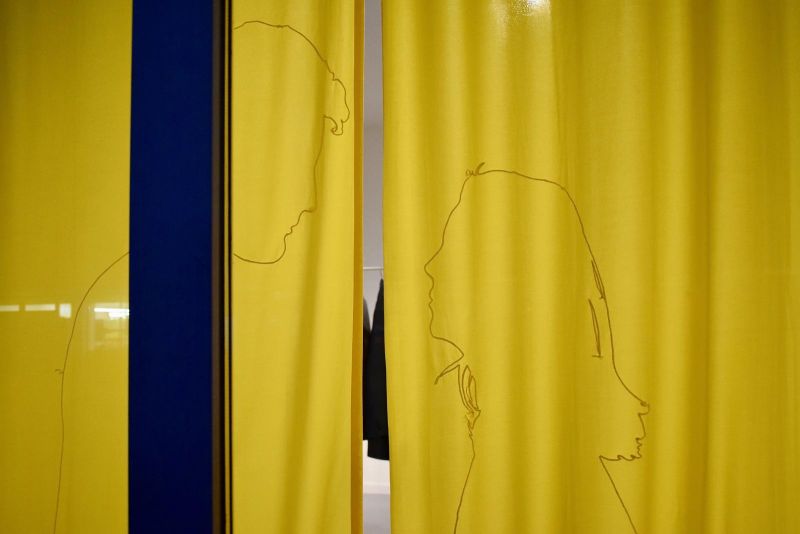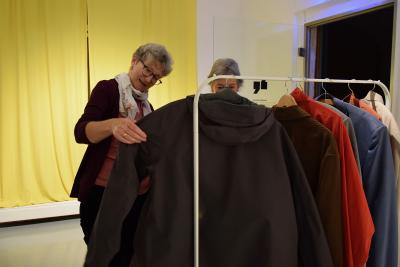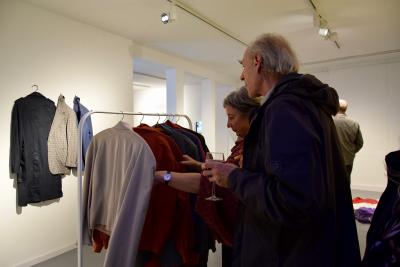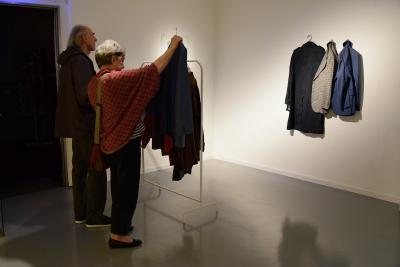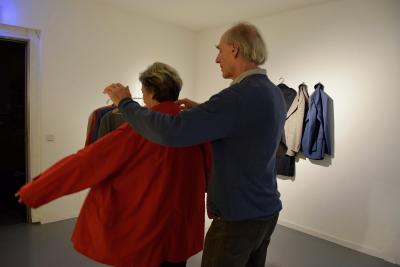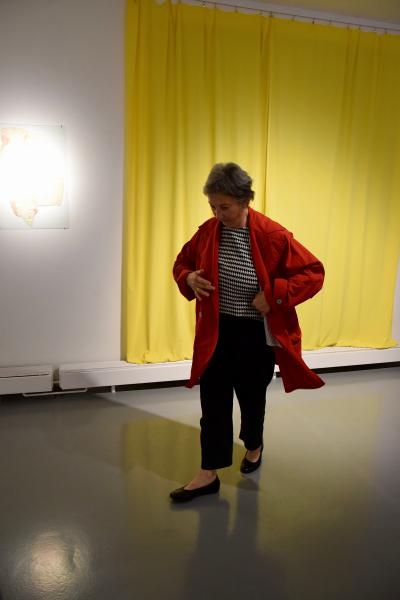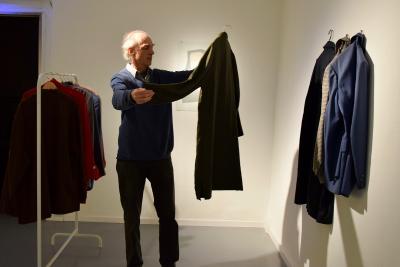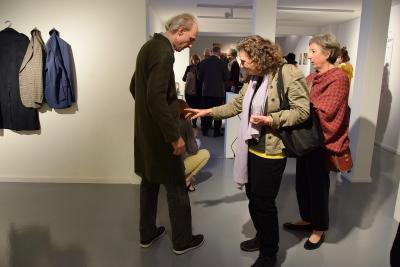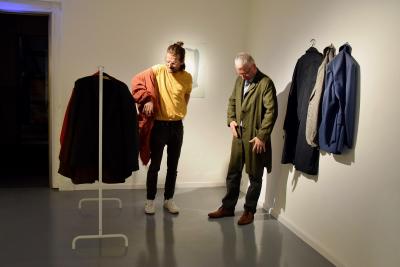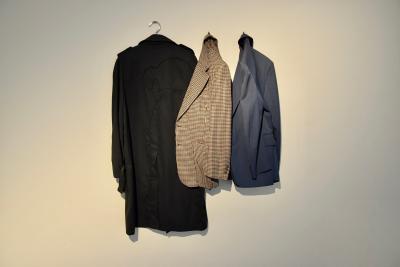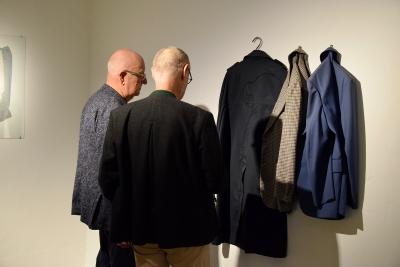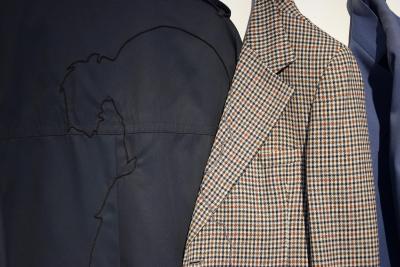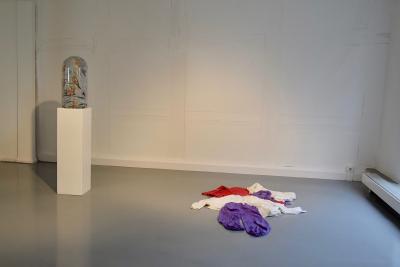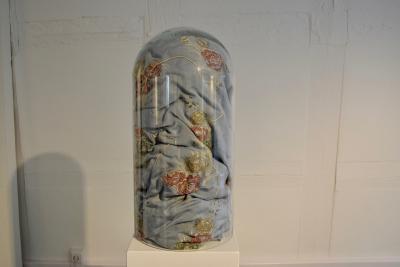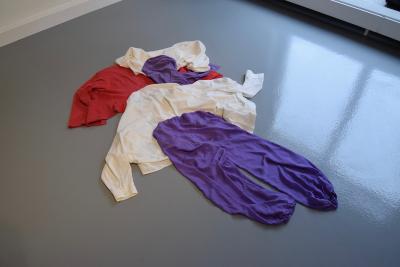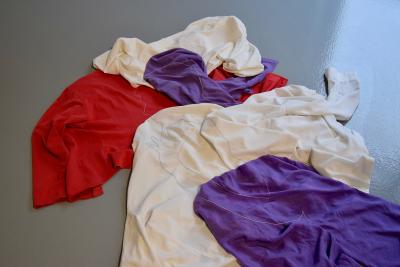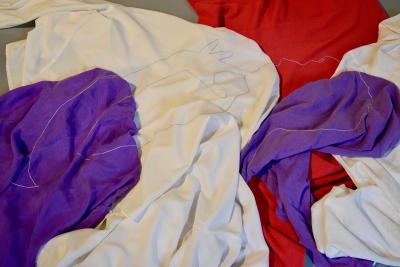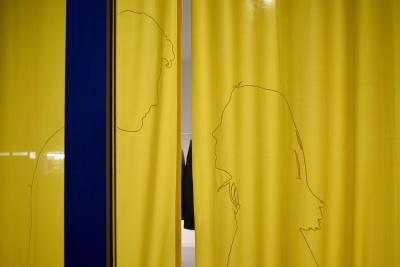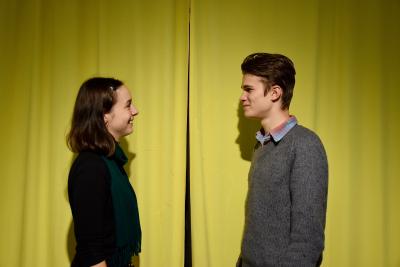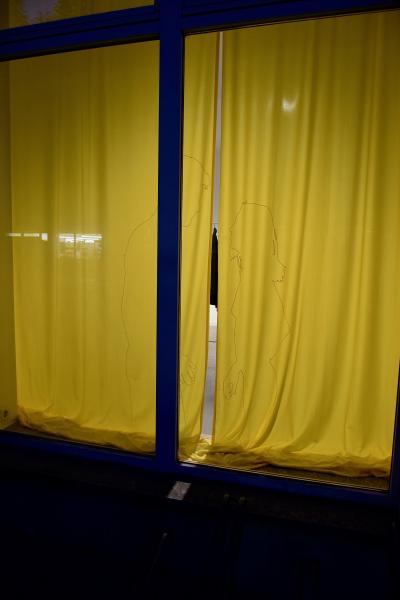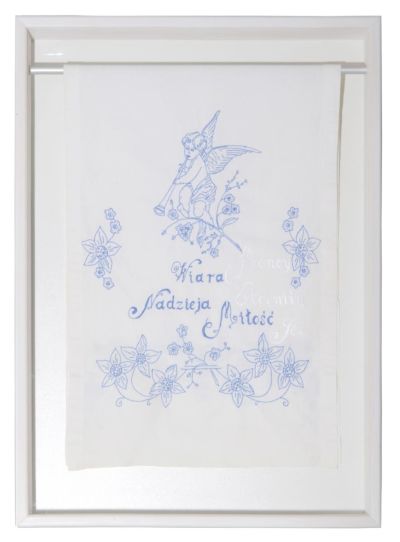A second look – Roland Schefferski in the Galerie Bernau
Mediathek Sorted

Here a curtain, there a coat, jackets, a bundle of scrunched up materials. Textiles, lying on the floor, casually arranged or under a glass cloche on a pedestal presented with idle sublimeness. One thing become clear quite quickly: Roland Schefferski works with materiality, with those things that are supposedly tangible and commonplace. But the first glance is deceptive. What initially seems tangible to the observer is an obviousness which can be found in all his works, along with the materiality. In the embroideries, the filigree drawings infiltrate and penetrate the flat surface of the material. Shadow-like outlines of human portraits emerge. But whose outlines can be seen? Or is it better to ask whether it is about the presence of the person portrayed at all?
The artist, who began his career as a painter and sculptor, turned his hand to object art in the early 1980s. His artistic creative field oscillated between environments, installations, initiatives and interventions, always taking various media into consideration. Inspired by objects from daily life, Roland Schefferski began to adapt his concepts to the places at which they were presented. He paid particular attention to rooting out marginal activities in the public arena. His observations are always characterized by the perception as a time and space-bound process which allows access to fundamental artistic thought – the conceptual part of the work – in the first place.
Roland Schefferski does not make it easy for the visitors to the exhibition. Implicitly, he invites the recipient to take a second look. A second analytical look which is based more on the analysis of the existential idea of the work than on that which is obviously recognisable. Central to this is the reference to context, that is to say, the construction and structure of the “art” system per se. You could say that it is a playful form of institutional critique. It is also a seemingly philosophical analysis which throws into question the independence of art within the context shown, and therefore influences and virtually exposes the observer’s perception in equal measures in order to consciously create intended associations and to activate and provoke new thought processes. Artistically and strategically, Schefferski creates a moment in which the observers seek the confrontation with the work as such. For this reason they come clad, embedded in material with embroidered outlines, posed not obviously but fundamentally, appearing to the observer upon a second look, believing them to be their own questions: What is art really? What is a work of art?
By giving the exhibition visitors the opportunity to enter into the work, to impose it upon themselves, to physically perform it, to sense it and to experience it perceptibly, the artist goes one step further. The interaction accompanying the exhibition “Die Berliner” invites you, for the time that you visit the exhibition, to swap your own outer clothing and wear jackets, blazers and coats embroidered with shadow-like marked outlines. This participatory concept “Die Berliner”, which is based on movement and dynamic, offers you the change to enter the exhibition room clad in the actual work. But also to leave the room and, in doing so, the work, which was originally bound to an institution, experiences an extension to become a form of art in the public arena. A participatory concept which dynamises the works and unites the separate spheres of art and life – at least momentarily. An attempt which quite obviously refers to the relationship between art work and exhibition site. When a work is shown in an institutional context, its status as a work of art is not called into question. However, the challenge faced by the actively involved recipient, when he temporarily leaves the building at the latest, is whether and how an artwork can stand up outside of this arena.
Schefferski has been pushing to establish his works outside the institutional art scene since the early 1980s. In the 1990s, he went so far as to give his works to a second hand shop in Berlin and on a commission basis to an antique shop in Gdansk. In so doing, he was aiming for a contemporary actualisation of that fusion between art and life that had already been propagated by Walter Gropius and the modernist avant-garde with the basic concept of Bauhaus in unifying art and craft. A practice which manifested itself in a different way and in an even more radical expression in the 1960s with the destruction of the panel painting and the performative steps towards an assimilation of art and life.
When one peers into the exhibition room, the assemblages, objects and installations distributed motionlessly through the room seem almost casually arranged, as if positioned by accident. One work stands out particularly: A curtain consisting of two individual panels of material in series in smooth transition. On the left, the embroidered outline of a female person can be seen, on the right that of a male. Both exposed, they stand opposite and facing each other. The portraits seem like shadows which remain despite their exposure to light. Like trusted companions which the artist gives to the observer. A small gust of wind blows through the exhibition room, the sun blinks through the window and everything is subject to change. External natural influences stimulate something processual, creating a symbiotic moment in which the actual static work is transformed to a dynamic piece of work. The curtain starts to move as if the two people portrayed are starting a dance-like dialogue with each other. The wind blows the male line to the side. The polarities which were so close, suddenly gape apart and distance takes the place of closeness.
Overall, it is clear that Roland Schefferski’s background is in painting and sculpting, and his early aspiration to conquer the sheet of paper and two-dimensionality is still current today. The embroideries of the seemingly filigree portrait break with traditional notions of sculpture and drawing. The thread is his graphical means of expression and his strength is doubtlessly in reducing it to the elementary line. Outlines of people, broken down to the individual line, are no longer constrained to the actual people portrayed, but instead adopt an abstract character. What remains is the form of the human figure in the room.
With this dynamic and transformative work – but especially with the “Die Berliner” interaction – Roland Schefferski ties in with Oskar Schlemmer’s confrontation with the corresponding relationship of figure and room and with the limited movement of sculptural works, which has been a theme for him. Schefferski’s interaction represents an adventure that can actually be experienced, a participatory work that is only discovered by incorporating the person and the room as a living artistic process. Similar to Franz West’s “Passstücken” or Franz Erhart Walther’s “Werksätzen”, his works need to be used to be activated. Whilst they do not use the stylistic elements of Bauhaus, its fundamental concepts find a kind of continuation in them. In the founding manifesto and Bauhaus programme of 1919, Walter Gropius asked the question what is a room and how could it be captured and designed. Assuming that every work relates to something bigger, he referred to the room as such and to the relevance of including actual and spiritual means.
Roland Schefferski’s room-bound works that underlie the processual can be interpreted as an example of transferring the modern and its programmatic principles to the present. An art form, which is multi-layered and which is not ossified – on the contrary, by concentrating on the somewhat marginal, it tackles that which is essential in the philosophically existential sense. An art form which asks the observer to take a deeper look. Or even a second!
Annabell Burger, November 2019

















































































